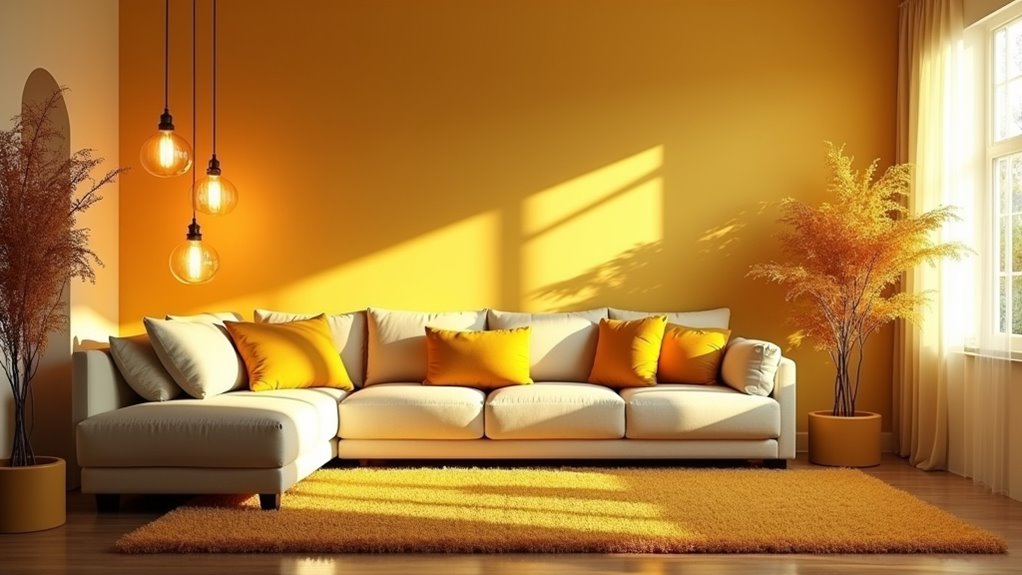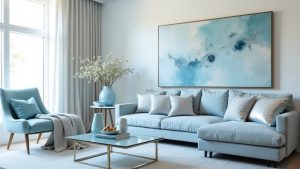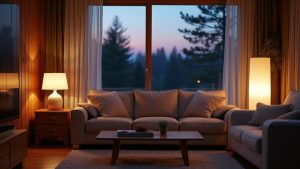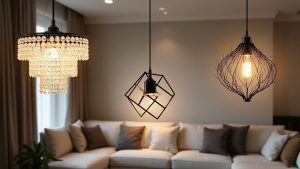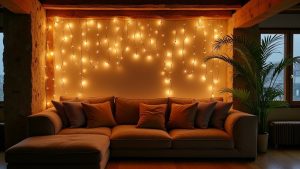Incorporating yellow light in a living room transforms the space into a warm, inviting retreat. Choose vibrant fixtures like pendant lights and bold chandeliers to capture attention and create ambiance. Layer lighting with ambient, task, and accent options for depth and comfort. Harmonize yellow light with your color scheme, using it to enhance neutrals or earthy tones. Dimmers provide control, adapting the glow throughout the day. Embrace energy-efficient options to maintain vibrancy. Discover more creative strategies to elevate your lighting experience.
Key Takeaways
- Select warm yellow light fixtures like pendant lights and chandeliers to create inviting focal points in your living room.
- Layer yellow light sources through ambient, task, and accent lighting to enhance comfort and functionality.
- Choose yellow light bulbs with a color temperature of 2700K to 3000K for a cozy, incandescent-like glow.
- Harmonize yellow light with your color scheme, enhancing neutral tones and complementing earthy palettes for warmth.
- Utilize dimmers to adjust yellow light intensity based on activities, improving mood and reducing eye strain.
Understanding the Warmth and Coziness of Yellow Light

Although often overlooked in the realm of lighting design, yellow light holds the key to creating a warm and inviting atmosphere in any living space. The psychology of yellow light evokes happiness and optimism, promoting mental alertness while instilling feelings of joy and cordiality. Its buttery tones simulate seasonal brightness, imbuing rooms with a cozy glow that feels alive and welcoming. When used thoughtfully, yellow light can inspire confidence and creativity, making it perfect for social gatherings. Yellow is associated with sunshine, happiness, intellect, and prosperity, which enhances the overall ambience when applied correctly. Light yellow shades can offer both warm and cool undertones, which can influence the mood of the room depending on how they interact with room orientation and lighting conditions.
Perfect for living rooms and bedrooms, yellow light fosters a sense of security and relaxation, enhancing comfort after a long day. The soft, golden hues reduce eye fatigue and mimic the soothing embrace of a sunset, ideal for unwinding. In essence, yellow light transforms spaces into intimate havens, enriching emotional well-being and inviting connection.
Choosing the Right Yellow Light Fixtures

When selecting yellow light fixtures for a living room, the interplay of design, function, and color can transform the space into a vibrant haven. Pendant lights create a delightful focus, while bold yellow chandeliers enrich high ceilings with warmth and elegance. Wall sconces provide stylish ambient lighting, framing key features like artwork or fireplaces, enhancing visual interest through strategic fixture placement. For intimate settings, yellow table lamps introduce task lighting, offering both practicality and bright color contrast. Fixtures made of materials such as glass or metal provide various textures and styles, enriching the room’s character. Utilizing natural coastal textures can also beautifully complement these fixtures, evoking a sense of tranquility and connection to nature. Ultimately, the choice of yellow fixtures not only illuminates but also infuses life into the living room’s atmosphere.
Layering Yellow Light for Ambiance

Layering yellow light in a living room elevates both the aesthetic appeal and functional comfort of the space, creating a harmonious interplay of warmth and illumination.
Employing effective layering techniques—ambiance, task, and accent lighting—transforms an ordinary room into a vibrant retreat. Ambiant yellow light serves as the base, offering a cozy wash of light that sets the foundational tone. Task lighting adds focused illumination, essential for activities like reading, while strategically placed accent lights draw attention to architectural details or artwork, creating visual interest and depth.
Harmonizing Yellow Light With Color Schemes

Harmonizing yellow light with various color schemes creates a captivating visual experience that elevates the ambiance of a living room. When paired with neutral schemes, warm yellow light enhances creams and beiges, crafting a cozy atmosphere, while cooler yellow shades illuminate grays, preventing a somber feel. In warmer color palettes, yellow light intensifies reds and complements earthy tones, creating a vibrant, energetic space. Conversely, cool color schemes benefit as yellow light enhances blues and greens, offering refreshing balance. For green shades, yellow light adds vitality, reminiscent of sunlight on foliage. Incorporating warm bulbs and dimmers can optimize the ambiance, ensuring the room remains a harmonious and inviting environment. Ultimately, achieving color harmony through the thoughtful integration of yellow light can transform a living room into a harmonious and inviting environment.
Incorporating Yellow Accents to Enhance Lighting

A subtle touch of yellow can dramatically enhance the lighting and ambiance of a living room, transforming it into a vibrant sanctuary.
Incorporating yellow accents, such as cheerful throw pillows or inviting rugs, can breathe life into the space.
Strategically placed yellow furniture, like a bold armchair or a stylish side table, becomes a captivating focal point that draws the eye while uplifting the overall atmosphere.
Yellow textiles, from curtains to blankets, can beautifully filter light, creating warmth and openness.
This versatile color harmonizes with various design styles, enriching the living room without overwhelming the senses.
Practical Considerations for Yellow Lighting

In any living room design, practical considerations for yellow lighting can significantly influence the overall aesthetic and ambiance. Yellow light bulbs, with a light temperature ranging from 2200K to 3000K, create a warm glow reminiscent of incandescent bulbs.
Selecting yellow LED options not only enhances coziness but also ensures energy efficiency. Strategic bulb placement is essential; using these bulbs in fixtures like wall sconces or bedside lamps highlights architectural features and zones within the room.
Careful consideration of color rendering is also vital, as yellow light can shift color perceptions. Overall, when paired with natural textures, yellow lighting fosters a serene atmosphere that invites relaxation while enhancing the warmth of wooden decor and neutral tones.
Using Dimmers for Light Control

Dimmers transform the living room by allowing precise control over light intensity, shifting seamlessly from vibrant illumination to a softer glow. This adaptability not only sets the mood for various activities—ranging from lively gatherings to quiet evenings—but also enhances the room’s functionality. With the warm embrace of yellow light gently adjustable at a touch, creating the perfect ambiance becomes an effortless endeavor. The use of dimmable LED bulbs provides flexibility for brightness adjustments, superior energy efficiency, and a longer lifespan for bulbs.
Control Light Intensity
Transforming the ambiance of a living room becomes effortless with the integration of dimmer switches, where light intensity can be finely adjusted to suit any moment.
By utilizing modern dimmers, such as trailing-edge types specifically designed for LED bulbs, homeowners can achieve a smooth transition in brightness while avoiding common issues like flickering. It is crucial to ensure dimmer compatibility with selected light bulb types, especially for those illuminating the room with warm yellow hues.
Whether opting for a smart dimmer for remote control or a rotary style for simplicity, adjusting the light to the desired intensity enhances the living experience.
Furthermore, dimming not only sets the mood but also promotes energy efficiency, making it an essential addition to any home.
Set the Mood
A harmonious atmosphere can be effortlessly crafted in a living room through the strategic use of dimmers.
These devices not only enhance the aesthetic of a space but also extend several yellow light benefits that improve overall mood. By adjusting the brightness, homeowners can create customized environments suitable for various occasions:
- Intimacy: Lower light levels foster cozy interactions, making the living room inviting for conversations.
- Relaxation: Dimmed yellow light promotes a calming environment, aiding in stress relief and enhancing overall comfort.
- Versatility: Dimmers allow for a smooth transition from vibrant gatherings to tranquil evenings, perfectly tailoring the ambiance for social or solitary activities.
Incorporating these adjustments ensures the living room remains a perfect retreat, enhancing every moment spent within its warm embrace.
Enhance Room Functionality
While enhancing room functionality, the use of dimmers offers a seamless way to adjust yellow light for various activities within a living room. Dimmers facilitate layered lighting, allowing homeowners to transition effortlessly between bright settings for reading or hobbies and softer, ambient settings for relaxation.
As natural daylight changes, the adaptability of dimmable yellow light can enhance comfort, signaling the body to unwind as evening approaches. By fine-tuning brightness levels, task performance improves while reducing glare and eye strain.
Additionally, energy efficiency is achieved, as dimmers lower electricity consumption and extend bulb lifespan. For optimal results, pairing dimmable LED yellow lights with compatible dimmers ensures functionality is both versatile and sustainable, making every moment in the living room a delightful experience.
Balancing Yellow Light With Natural Light

Achieving a harmonious balance between yellow artificial light and natural daylight can elevate the ambiance of a living room, creating an inviting atmosphere.
To effectively manage this interplay, one may consider the following strategies:
Consider various strategies to harmonize yellow artificial light with natural daylight for an inviting living room ambiance.
- Window Treatment Strategies: Utilize sheer or light-filtering treatments to diffuse natural light, eliminating glare while maintaining brightness.
- Understanding Natural Light Dynamics: Recognize how room orientation affects light quality; for instance, south-facing rooms may need moderation to maintain color integrity.
- Layering Techniques: Combine ambient, task, and accent lighting with yellow tones that correspond to the shifting qualities of natural light throughout the day, ensuring a warm, balanced environment.
Selecting Energy-Efficient Yellow Lighting Options

When selecting yellow lighting options for a living room, the emphasis on energy efficiency transforms both the aesthetic and practical aspects of illumination.
Energy saving bulbs, particularly LED options, thrive in this role, producing a warm yellow glow that falls within the desirable 2700K to 3000K light temperature range.
Unlike traditional incandescent bulbs, which waste 90-95% of energy as heat, LEDs convert most electrical input directly into light, offering both longevity and cost-effectiveness.
Compact Fluorescent Lamps (CFLs) can also provide a warm hue but lack the instant brightness and environmental safety of LEDs.
For those seeking efficiency and vibrant illumination, choosing LED bulbs ensures a cozy atmosphere while significantly reducing energy consumption over time.
Styling Tips for Yellow Light in Various Design Themes

Yellow light can dramatically enhance a living room’s design, infusing warmth and vibrancy across various styles. Its psychological effects, such as promoting comfort and relaxation, make it ideal for seasonal lighting changes.
Here are three styling tips for integrating yellow light:
- Modern Design: Utilize sleek, metallic fixtures paired with neutral palettes, allowing yellow light to create focal points on artworks or shelving.
- Scandinavian Design: Opt for minimalist lamps that mimic candlelight, ensuring a gentle diffusion of yellow light, especially near large windows.
- Bohemian Design: Layer yellow light sources such as woven lamps and string lights against rich, earthy tones to cultivate a cozy, eclectic space.


